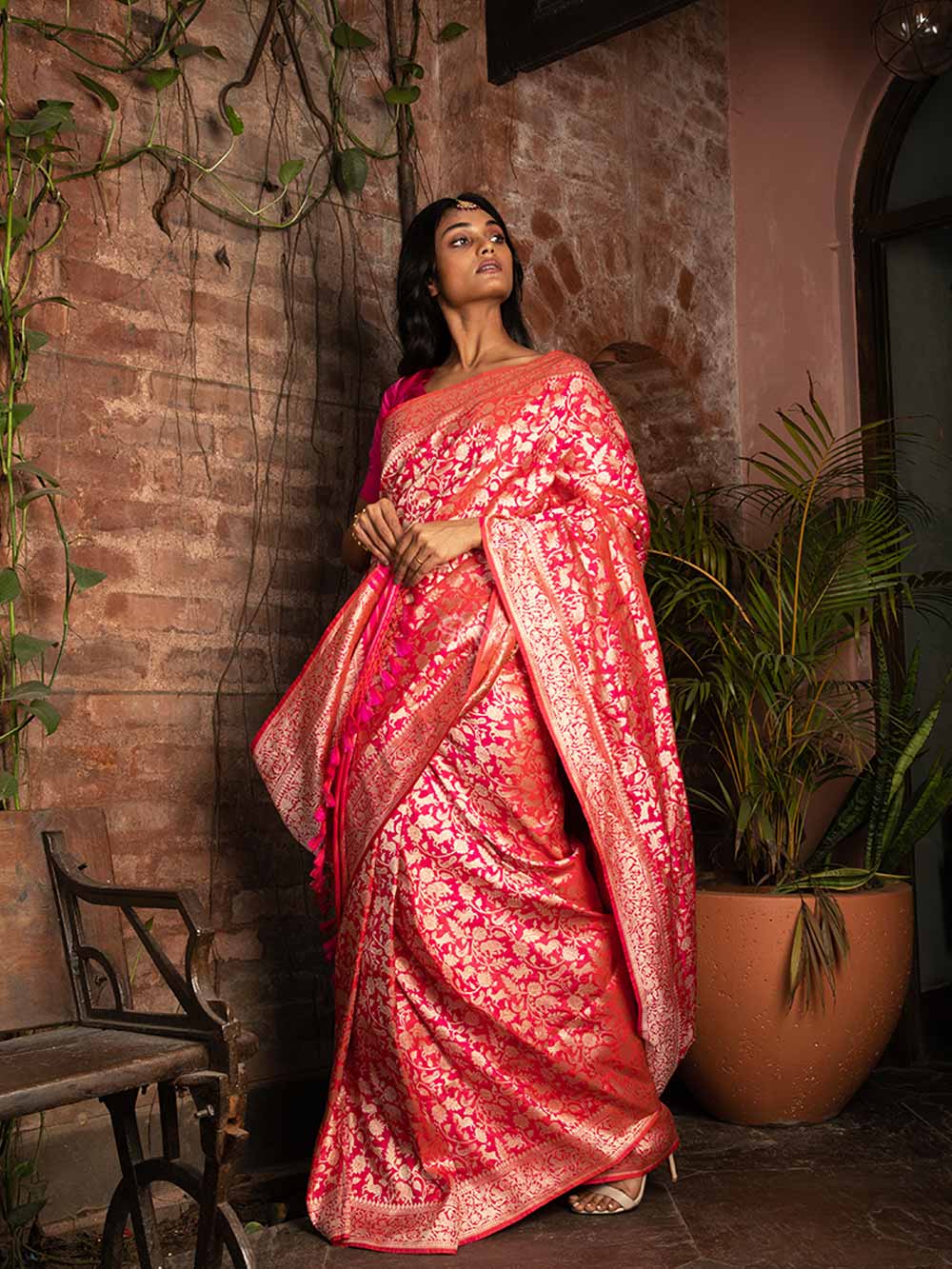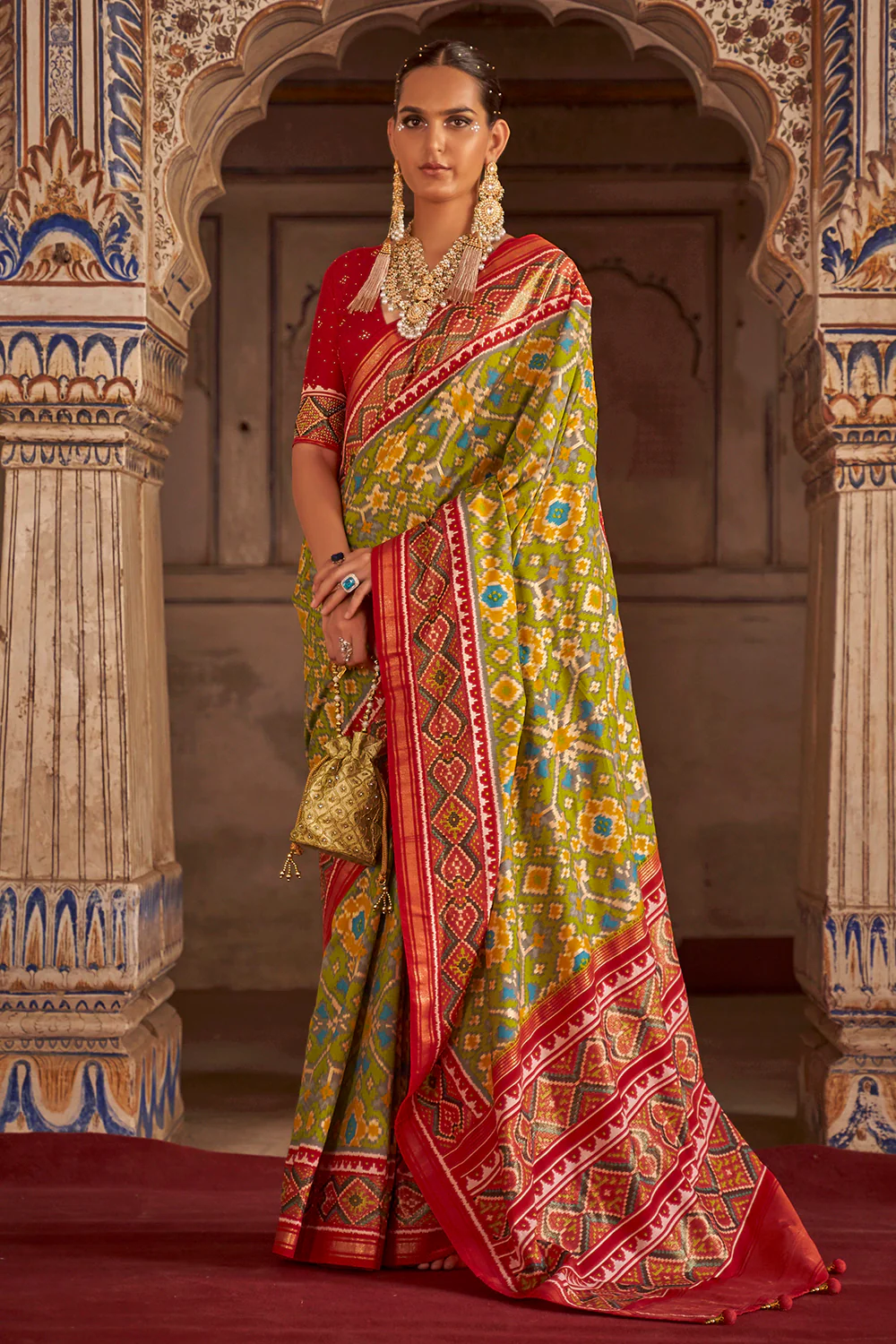Different Types of Sarees in India [Regional and Traditional]
India is a land of diverse cultures, and this diversity is beautifully reflected in its traditional sarees. Each state in India boasts its unique style of saree, weaving techniques, and cultural significance.
These sarees are not just garments but are stories woven in threads, representing the heritage of the region. Let’s take a journey across India and explore the different types of sarees that each state proudly offers.
Kanjeevaram Saree – Tamil Nadu

Kanjeevaram sarees are the epitome of elegance and are known for their rich texture, vibrant colors, and exquisite gold thread work.
Originating from Kanchipuram, these sarees are often adorned with temple designs, checks, and floral motifs, making them perfect for weddings and grand celebrations.
Banarasi Saree – Uttar Pradesh

Banarasi sarees from Varanasi are renowned for their intricate brocade work, gold and silver zari, and fine silk fabric.
These sarees are a favorite for bridal trousseaus due to their royal and luxurious appeal. They often feature Mughal-inspired designs like paisleys and floral patterns.
Patola Saree – Gujarat

Patola sarees are double ikat woven sarees from Patan in Gujarat. Known for their vibrant colors and geometric patterns, these sarees are considered a status symbol. Each Patola saree is a work of art, requiring months of meticulous craftsmanship.
Paithani Saree – Maharashtra

Originating from Paithan, Maharashtra, Paithani sarees are famous for their exquisite peacock motifs and vibrant colors.
Woven in silk, these sarees feature a contrasting zari border and pallu, often depicting nature-inspired designs like flowers, parrots, and lotus.
Muga Silk Saree – Assam

Assam’s Muga silk sarees are known for their natural golden sheen and durability. Made from the silk of the Antheraea assamensis worm, these sarees often feature traditional Assamese motifs like jaapi (a traditional hat), tree of life, and geometric patterns.
Sambalpuri Saree – Odisha

Sambalpuri sarees are handwoven ikat sarees from Odisha, characterized by their unique tie-dye technique.
These sarees often feature traditional motifs like shankha (shell), chakra (wheel), and phula (flower), and are revered for their intricate craftsmanship and vibrant colors.
Pochampally Saree – Telangana

Pochampally sarees, also known as Pochampalli ikat, are famous for their geometric patterns and vibrant hues.
Originating from the town of Bhoodan Pochampally in Telangana, these sarees are crafted using the ikat dyeing technique, where the yarns are dyed before weaving.
Chanderi Saree – Madhya Pradesh

Chanderi sarees from Madhya Pradesh are known for their sheer texture and lightweight fabric.
Woven from silk and cotton, these sarees often feature traditional motifs like coins, peacocks, and floral art, making them perfect for festive occasions and formal events.
Bhagalpuri Silk Saree – Bihar

Bhagalpuri silk sarees, also known as Tussar silk sarees, originate from Bhagalpur in Bihar.
These sarees are admired for their rich texture and natural gold color. They often feature intricate embroidery and traditional motifs, making them a timeless addition to any wardrobe.
Kasavu Saree – Kerala

Kasavu sarees, also known as Kerala sarees, are traditionally white or off-white sarees with a golden border.
These sarees are an integral part of Kerala’s culture and are typically worn during festivals and special occasions. The simplicity and elegance of Kasavu sarees make them stand out.
Bandhani Saree – Rajasthan and Gujarat

Bandhani sarees are created using a tie-dye technique, resulting in vibrant and colorful patterns.
Popular in Rajasthan and Gujarat, these sarees feature intricate designs made by plucking the cloth with fingernails into many tiny bindings, forming a figurative design.
Baluchari Saree – West Bengal

Baluchari sarees from West Bengal are known for their elaborate pallu designs depicting mythological scenes and narratives.
Woven from silk, these sarees feature intricate patterns and motifs that are often inspired by epics like the Ramayana and Mahabharata.
Gadwal Saree – Andhra Pradesh

Gadwal sarees from Andhra Pradesh are celebrated for their intricate borders and pallu, which are often woven separately and then attached to the body of the saree.
These sarees are typically made of cotton with a silk border, making them both comfortable and elegant.
Phulkari Saree – Punjab

Phulkari, meaning “flower work,” is a traditional embroidery technique from Punjab.
Phulkari sarees are adorned with vibrant and intricate floral patterns, typically embroidered with silk threads on cotton or khadi fabrics.
These sarees are perfect for adding a splash of color to any occasion.
Conclusion
Traditional sarees from different states of India are a testament to the country’s rich cultural heritage and diverse craftsmanship.
Each saree tells a unique story, reflecting the traditions, art, and history of its region. Whether it’s the regal Kanjeevaram from Tamil Nadu or the vibrant Bandhani from Gujarat, these sarees are more than just garments they are a celebration of India’s timeless beauty and tradition.
Embrace the variety and add these exquisite pieces to your wardrobe to experience the rich tapestry of Indian culture.
Theethnicworld is the most trusted online wholesale sarees store for ladies. We sell high-quality authenticated branded sarees at cheap prices.
